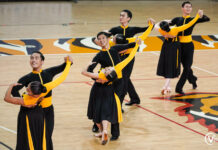AMID an attempt by the country’s top basketball organization to unite the two most prestigious collegiate cage leagues, UAAP president and Institute of Physical Education and Athletics Director Fr. Ermito de Sagon, O.P. has stood firm against any move to merge the UAAP and the NCAA.
“The UAAP vastly varies in culture, history and tradition compared to the NCAA. We do not want to bury the legacy of each league,” de Sagon told the Varsitarian. “UAAP is UAAP; it has struggled through the years to be what it is today.”
The idea of unifying the two leagues first surfaced during the Christmas break when Season 71 host University of the Philippines (UP) proposed the merger of UAAP and NCAA’s upcoming basketball seasons in line with its 100th anniversary. UP is a founding member of both leagues.
De Sagon, however, noted that these use no mention of the UP centennial in Samahang Basketball ng Pilipinas president Manuel V. Pangilinan’s letter to the UAAP board last January 7.
Instead, Pangilinan’s letter to de Sagon described the proposed UAAP-NCAA merger as a national objective “to create an avenue to identify, recruit and train the best basketball talents available nationwide.”
The SBP also suggested the creation of an ad-hoc committee that will ensure the smooth and orderly process of unification.
The committee will be composed of a chairman, three members each from the UAAP and the NCAA boards, the SBP executive director, a lawyer, and an executive representative from broadcast giant ABS-CBN, which airs UAAP and NCAA games through UHF station Studio 23.
“If they (SBP) are after national interest, why did they not involve other leagues around the country?” de Sagon asked. “I should not put malice on their intention because they are good people, but I’m just being cautious.”
Representatives from other UAAP-member schools shared de Sagon’s sentiments, voting unanimously last December to scrap the proposed merger.
SBP executive director Patrick Gregorio stressed in the major dailies during the holidays that he never used the term “merger.” The letter of proposal only said, “Let’s play together in 2008?” But de Sagon said the words “fusion,” “unification,” “combination” and “bringing together” as stated in Pangilinan’s letter mean the same thing.
But the league is open to proposals for a national championship like the off-season tournament Champions League, but is against a merger which entails longer playing seasons, de Sagon said.
“We must remember these athletes are students first and not the other way around,” he said. “Playing basketball for a year would interrupt their academics.”
Pangilinan’s letter referred to a unification of the two leagues in the basketball season. There was no mention of the 14 other UAAP sports.
“We are not interested in an action that will alienate the other sports,” de Sagon said. “The UAAP is not a basketball league.”
He added that money coming from the television coverage and gate receipts during basketball games helps paying for the venues of other sports like tennis and football that do not charge patrons.
Separating basketball from the UAAP will cripple these other sporting events, de Sagon said.
UST along with the of the Philippines, Ateneo de Manila University, De La Salle University, Far Eastern University, National University, San Beda College, and the University of Manila established NCAA in 1924. But in 1930, University of the Philippines protested against the move of the NCAA Board of Directors to submit papers of NCAA’s inclusion with the Bureau of Commerce.
UST and NU’s support to UP resulted in the formation of a league dubbed as “Big Three,” a meet between the three schools.
In 1936, UST and UP permanently withdrew from the league. After two years, the two schools together with NU and FEU, which has also pulled out from the NCAA formed a new league, the UAAP.

















